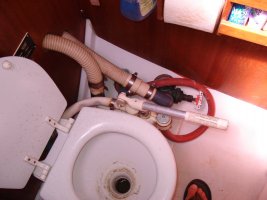agraziano23
Member II
Hello,
I'm a new owner of a '76 E27 that although very sound needs a lot of esthetic attention. Hopefully I attached the picture correctly. My first of many questions is about the head. It does not have a deck connection for pump out. There are 2 through hulls I beleive that the larger one is for discharge, but what is the second one? There are two water tanks in the V berth compartment one is for the toilet water I assume, also there is a bottle resembling a clorox bottle, I also assume that's where the tank treatment chemicals go. I have not seen the waste tank itself in my inspection of the boat ( I will pick it up this week end) There is also a manual pump in the V berth that the PO say is for puimping the waste overboard. Also there is a electronic panel that shows when the waste tank is full (not sure if it works)
Can some one please give me guidence on how this system works? how do I get it pumped out? I'm now used to all this hoses and thru-hulls, my previous boat being a Humter 23 with outboard and porta-potty.
THanks in advance.
TonyG in NJ.

I'm a new owner of a '76 E27 that although very sound needs a lot of esthetic attention. Hopefully I attached the picture correctly. My first of many questions is about the head. It does not have a deck connection for pump out. There are 2 through hulls I beleive that the larger one is for discharge, but what is the second one? There are two water tanks in the V berth compartment one is for the toilet water I assume, also there is a bottle resembling a clorox bottle, I also assume that's where the tank treatment chemicals go. I have not seen the waste tank itself in my inspection of the boat ( I will pick it up this week end) There is also a manual pump in the V berth that the PO say is for puimping the waste overboard. Also there is a electronic panel that shows when the waste tank is full (not sure if it works)
Can some one please give me guidence on how this system works? how do I get it pumped out? I'm now used to all this hoses and thru-hulls, my previous boat being a Humter 23 with outboard and porta-potty.
THanks in advance.
TonyG in NJ.




